How a Nearly Century-Old Textile Maker Went Digital

It’s no easy feat to transform a struggling family business into a thriving digital enterprise, but that’s exactly what Cooley Group President and CEO Dan Dwight is doing.
Change for the better: Cooley Group was formed in 1926 as a family-run textile manufacturer in Rhode Island. In 2011, Dwight, a member of the NAM Board of Directors, joined the company as president and CEO to navigate the ship through a new age of manufacturing and market demands.
- Today, the private equity-backed extrusion and textile manufacturer is the leading global maker of polymer-coated textiles. Applications range from single-use blood-pressure-cuff materials, to proprietary urethane combat raiding crafts for U.S. special forces, to liners and covers for some of the world’s largest water reservoirs.
How they did it: “As a family-run business, Cooley inherited aging equipment and an aging workforce,” said Dwight, who also serves as vice chairman of the Manufacturing Leadership Council’s Board of Governors. (The MLC is the NAM’s digital transformation arm.)
- “We not only modernized our equipment and infrastructure to compete in the digital age, but also revolutionized our culture. Hierarchies slowed us down.”
- “Digital transformation isn’t only beneficial for the advancement of our physical technologies; it’s also critical to develop a more collaborative company culture that empowers employees at all levels to take action.”
Starting small: “Digital transformation—the integration of digital technology into all facets of an organization—can seem daunting at first,” Dwight said. “But that can’t deter an organization from jumping in.”
- “I advise companies, particularly mid-sized manufacturers like Cooley Group, to approach digital transformation incrementally,” he said. “Don’t expect the cultural, institutional or technological benefits of digital transformation to manifest overnight as some mega-solution.”
- “Think strategically about the areas of your business that are the first movers. Once one aspect of the business is modernized, the digital insights and team’s enthusiasm for change will build momentum to push the remaining pieces into place.”
Gaining momentum: The transformation of this firm of 300 people is ongoing. “Ten years ago, we had trouble keeping our equipment operating for any period of time,” Dwight said. “Now everything in all our factories is digitally [Manufacturing 4.0]-driven across a single operating platform.”
- The company plans to do the pilot phase of an artificial intelligence implementation later this year.
Figuring it out: The MLC was key in Cooley Group’s remarkable transformation, according to Dwight.
- “I’m not sure we would have figured it out on our own,” he admits. “I’m an avid reader; I was born excited to build things. I read a lot about manufacturing and leadership. But even if I could have figured out M4.0 strategy, actually implementing it on the plant floor would have been difficult without the support of MLC members to share best practices and to encourage the Cooley team to embrace transformation.”
Get involved: Companies can jumpstart their own digital transformation by attending Rethink, the MLC’s premier event for manufacturing executives, in Florida on June 26–28. Check it out here.
Small Manufacturers Win Big with Digital Transformation

For small and medium-sized manufacturers, digital transformation can seem like an especially harrowing task. But smaller organizations can be uniquely positioned for success in implementing firmwide digital strategies.
Small but mighty: Just look at Graphicast, a 25-person precision metal parts company in Jaffrey, New Hampshire.
- “Because the cost of data collection and analytics is getting lower and lower, even as a small company we can collect data at a rate that gives us meaningful information we can act upon,” said Graphicast President Val Zanchuk. “For example, we created a linear programming model of our business. If we’re growing at a certain rate, I can use it to determine the most economical next steps, such as whether we should hire more people, work overtime or purchase more equipment.”
A workforce solution: Graphicast, which counts Fortune 100 companies among its clientele, has used cloud computing, AI-based systems and more to help it succeed, according to Zanchuk.
- The manufacturer is also looking into the use of collaborative robots as a potential solution to the labor force shortage.
- “When it comes to Manufacturing 4.0, we think about what our customers will be looking for from us in terms of digital collaboration,” said Zanchuk, adding that some of the business’s larger customers are “transforming at a different rate than we are.” That means it’s up to Graphicast to consider client expectations and see how best to meet them given “what’s financially and operationally feasible” for the company.
The MLC helps out: To aid in Graphicast’s digital transformation, Zanchuk joined the Manufacturing Leadership Council, the NAM’s digital transformation division.
- “The MLC is the only place I know where I can discuss broad industry trends in an open fashion, where small companies like mine and large companies like Ford or GM can all be involved in the discussion,” said Zanchuk, who serves on the MLC Board of Governors.
- “Being part of the MLC lets us know if we’re on the right track and how we can make adjustments,” he continued. “It connects us to a group of incredibly talented, intelligent and experienced people who are focused on many of the same operational challenges we face.”
Witnessing World Class Manufacturing at Whirlpool Corporation
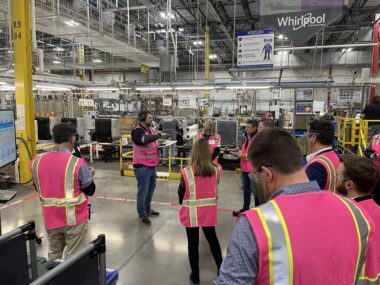
When Whirlpool Corp.’s Findlay Operations began its World Class Manufacturing (WCM) journey in 2018, the effort was envisioned as a standardized way to drive out waste and loss while keeping their customers in mind.
In March, the Whirlpool team welcomed guests for the Manufacturing Leadership Council’s sold-out tour of the company’s Findlay, Ohio, factory, where visitors learned about the WCM methodology, witnessed the facility in action, and heard directly from company leaders. The visit included information about automation efforts, sustainability programs, training programs, data collection and use, maintenance procedures, and kaizen and other continuous improvement processes.
The nearly 2,200 employees at the Findlay facility manufacture thousands of dishwashers each day including stainless steel and plastic tub varieties. The factory first opened in 1967 and has seen several additions, growing its footprint to one million square feet today. It is one of five Whirlpool manufacturing centers in Ohio and among 56 manufacturing and technology centers worldwide. In 2022, Whirlpool recorded $19.7 billion in net sales.
About World Class Manufacturing: Whirlpool Corp.’s Findlay Operations transitioned from a system based on the Toyota Production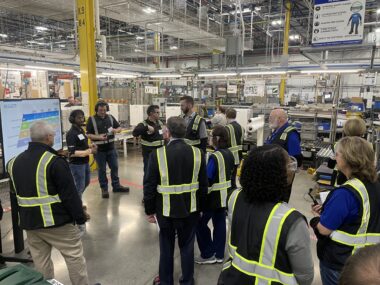 System to WCM in 2018. WCM features 10 Technical Pillars that are built on top of 10 Managerial Pillars. Both are essential to achieve WCM status. WCM’s primary goal is to increase quality while reducing production costs. The operating model focuses on driving out waste and loss by demonstrating successful pilot processes that are then spread broadly via standardization.
System to WCM in 2018. WCM features 10 Technical Pillars that are built on top of 10 Managerial Pillars. Both are essential to achieve WCM status. WCM’s primary goal is to increase quality while reducing production costs. The operating model focuses on driving out waste and loss by demonstrating successful pilot processes that are then spread broadly via standardization.
The WCM audit system has revealed significant progress at Whirlpool, Findlay Operations. Two times per year, the plant is audited by external parties to assess their progress against the WCM methodology. As pillars progress and meet specific criteria, they are awarded points. In the fall of 2022, the Findlay plant scored 53 points during their WCM audit. A score of 50 or more results in being awarded the Bronze-level award for WCM. The next milestone is at 60 points which is a Silver-level award. This scoring is standard for those using the WCM methodology.
What They Saw: For the nearly 100 MLC attendees, the highlight was seeing Whirlpool Corp.’s operation in action.
To make their way around the bustling factory, attendees were broken into seven tour groups, each named after a Whirlpool brand: Maytag, KitchenAid, Amana, JennAir, Swash, Gladiator, and the flagship brand Whirlpool.
During the seven-stop journey, tour leaders shared concrete examples of how standard work is put into practice and how continuous improvement, Kaizen activities and the Plan-Do-Check-Act (PDCA) cycle affect processes and help the company balance safety, quality, and costs. In fact, at the Workplace Organization stop, participants learned how the plant’s Kaizens have saved the plant millions of dollars since 2019.
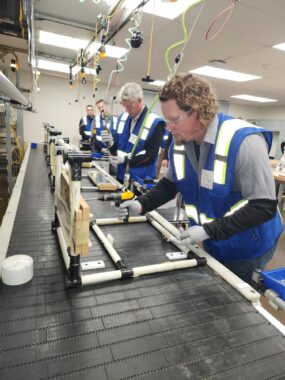 Along the route, participants saw Automated Guided Vehicles (AGVs) deliver supplies to workstations and heard from tour leaders and frontline leaders. At one stop, guests learned how flipping the dish rack when installing rack clips had saved time, avoided awkward hand and head angles, and decreased worker frustration. Elsewhere, a new lever – 3D printed on site – allowed workers to reduce the force necessary to install the dishwashers’ sump pumps, resulting in a five-year period without a reportable incident and two years without any first aid incidents.
Along the route, participants saw Automated Guided Vehicles (AGVs) deliver supplies to workstations and heard from tour leaders and frontline leaders. At one stop, guests learned how flipping the dish rack when installing rack clips had saved time, avoided awkward hand and head angles, and decreased worker frustration. Elsewhere, a new lever – 3D printed on site – allowed workers to reduce the force necessary to install the dishwashers’ sump pumps, resulting in a five-year period without a reportable incident and two years without any first aid incidents.
At yet another tour stop visitors saw an automated cell completing a foam-in-place process featuring a robot that has run millions of cycles to date. The company uses automation like this to avoid the 3Ds: tasks that are dull, dirty, or dangerous. Automation allows the company to avoid these 3Ds while providing safer and more interesting work to take place.
Off the factory floor, tour stops included a visit to the Compass Room where data on every machine and process is analyzed so the company can ensure safety and quality while reducing waste. The room provides a place for company leaders to look at the full picture, tie waste back to its root cause, and figure out priorities to address the top losses. From there, the groups also stopped for an overview of the company’s sustainability efforts, which include a pledge to achieve net zero by 2030 with the help of two on-premises wind turbines.
Finally, tour groups visited the Manufacturing Training Area (MTA) where the company demonstrated the training process that employees go through to learn new skills or brush up on existing capabilities. Every new hire starts their Whirlpool experience in Findlay’s MTA. In this training area, staff assess employees and then assign them to stations on the factory floor where they can operate safely and efficiently while measuring up to Whirlpool’s quality standard. To avoid monotony and repetitive stress injuries, Whirlpool workers each have at least three jobs they can do in the factory. Each worker rotates his or her position on the line to undertake these approved job functions during each shift. In fact, some workers are certified in as many as nine frontline jobs.
Diving Deeper During Breakouts and An Expert Panel: The plant tour concluded with three breakout sessions followed by an open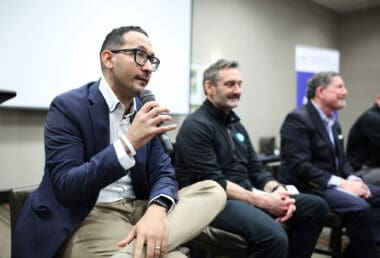 question and answer session with Whirlpool leaders. The breakouts allowed participants to learn more and ask questions about WCM, the Kaizen Management System, or MTA and People Development.
question and answer session with Whirlpool leaders. The breakouts allowed participants to learn more and ask questions about WCM, the Kaizen Management System, or MTA and People Development.
The tour contingent reconvened for an expert panel moderated by David R. Brousell, MLC’s co-founder and executive director. During a lively session, participants were able to pick the brains of some of Whirlpool’s brightest minds including Kristin Day, Findlay Operations Plant Leader; Ramsey Aljahmi, Operations Excellence Lead, NAR; Scot Blommel, Senior Manager, Global Sustainability; and Brent Schnipke, Ottawa Operations Plant Leader.
Award-Winning Leaders: There is no shortage of industry expertise and award-winning talent at Whirlpool’s Findlay plant. Kristin Day was recognized as a 2020 STEP Ahead Honoree by the Manufacturing Institute (MI), the nonprofit workforce development and education partner of the National Association of Manufacturers, MLC’s parent. Additionally, Industrial Engineering Manager, Tyra Woodruff, was honored with a STEP Ahead award in 2022, while Amy Doroff, Senior Manager, Material Control and Logistics, was honored as an MI Emerging Leader that same year. Now called the Women MAKE America Awards, the program recognizes women who have achieved success within their companies and proven to be leaders throughout the entire industry. MI’s Emerging Leaders are young women who have demonstrated exceptional accomplishments as they begin their careers.
MLC’s next plant tour will be at The Hershey Company on May 1-2. For more information about upcoming MLC plant tours: https://www.manufacturingleadershipcouncil.com/event/plant-tours/
Announcing the 2023 Manufacturing Leadership Award Finalists

The Manufacturing Leadership Council—the NAM’s digital transformation division—has announced the finalists for the 2023 Manufacturing Leadership Awards, the industry’s premier awards program for achievements in digital manufacturing. You can read the complete list of finalists here.
The ceremony: The finalists will be honored at the Manufacturing Leadership Awards Gala in Marco Island, Florida, on June 28.
- Also announced at the gala will be winners for all project and individual categories, winners of the Manufacturing in 2030 Award, the Manufacturing Leader of the Year, the Small/Medium Enterprise Manufacturer of the Year and the Large Enterprise Manufacturer of the Year.
Rethink: Certain award winners will also present at Rethink, the industry’s leading event for exploring manufacturing’s digital era, which will also take place in Marco Island on June 26–28.
The categories: The awards are divided into nine project categories to recognize company achievements:
- Artificial Intelligence and Machine Learning
- Collaborative Ecosystems
- Digital Network Connectivity
- Digital Supply Chains
- Engineering and Production Technology
- Enterprise Technology Integration
- Operational Excellence
- Sustainability and the Circular Economy
- Transformational Business Cultures
Additionally, individual leaders are recognized in the Digital Transformation Leadership and Next-Generation Leadership categories.
The last word: “As more manufacturers extend digital’s reach onto the factory floor and throughout their operations, we are witnessing transformative performance improvements that would have been unthinkable just a few short years ago—and that are improving life for employees and customers alike,” said MLC Co-Founder, Vice President and Executive Director David R. Brousell.
Congratulations to the 2023 Manufacturing Leadership Award Finalists
Finalists and winners to be recognized at gala on June 28
Washington, D.C. – The Manufacturing Leadership Council, a division of the National Association of Manufacturers, today revealed the list of world-class manufacturing companies and individual leaders recognized as finalists for the 2023 Manufacturing Leadership Awards, the industry’s premier awards program for achievements in digital manufacturing.
“As more manufacturers extend digital’s reach onto the factory floor and throughout their operations, we are witnessing transformative performance improvements that would have been unthinkable just a few short years ago—and that are improving life for employees and customers alike,” said MLC Co-Founder, Vice President and Executive Director David R. Brousell. “The finalists recognized for this year’s awards represent the pinnacle of those achievements and exemplify possibilities for digital manufacturing.”
Select award winners will present their projects at Rethink: The Manufacturing Leadership Council Summit, the industry’s leading event for exploring manufacturing’s digital era. “Rethink is a must-attend for any manufacturer who wants to know more about digital transformation, whether they are just starting the journey or are much further along,” Brousell said. “It’s an unparalleled opportunity for manufacturing leaders to connect and learn from each other and then apply those learnings to their own businesses.”
Background: All finalists will be recognized on stage at the Manufacturing Leadership Awards Gala, which will take place at 7:00 p.m. EDT on June 28, 2023, at the JW Marriott Marco Island Beach Resort in Florida.
Also announced at the gala will be winners for all project and individual categories, winners of the Manufacturing in 2030 Award, the Manufacturing Leader of the Year, the Small/Medium Enterprise Manufacturer of the Year and the Large Enterprise Manufacturer of the Year.
See the complete list of 2023 Manufacturing Leadership Award finalists here.
The 2023 awards feature nine project categories to recognize company achievements:
- Artificial Intelligence and Machine Learning
- Collaborative Ecosystems
- Digital Network Connectivity
- Digital Supply Chains
- Engineering and Production Technology
- Enterprise Technology Integration
- Operational Excellence
- Sustainability and the Circular Economy
- Transformational Business Cultures
Additionally, individual leaders are recognized in the Digital Transformation Leadership and Next-Generation Leadership categories.
Rethink will take place at the JW Marriott Marco Island Beach Resort in Florida on June 26–28, 2023. Details are available here. Nominations for the 2024 Manufacturing Leadership Awards will open in August.
Survey: Data Mastery is Slow to Mature but Essential
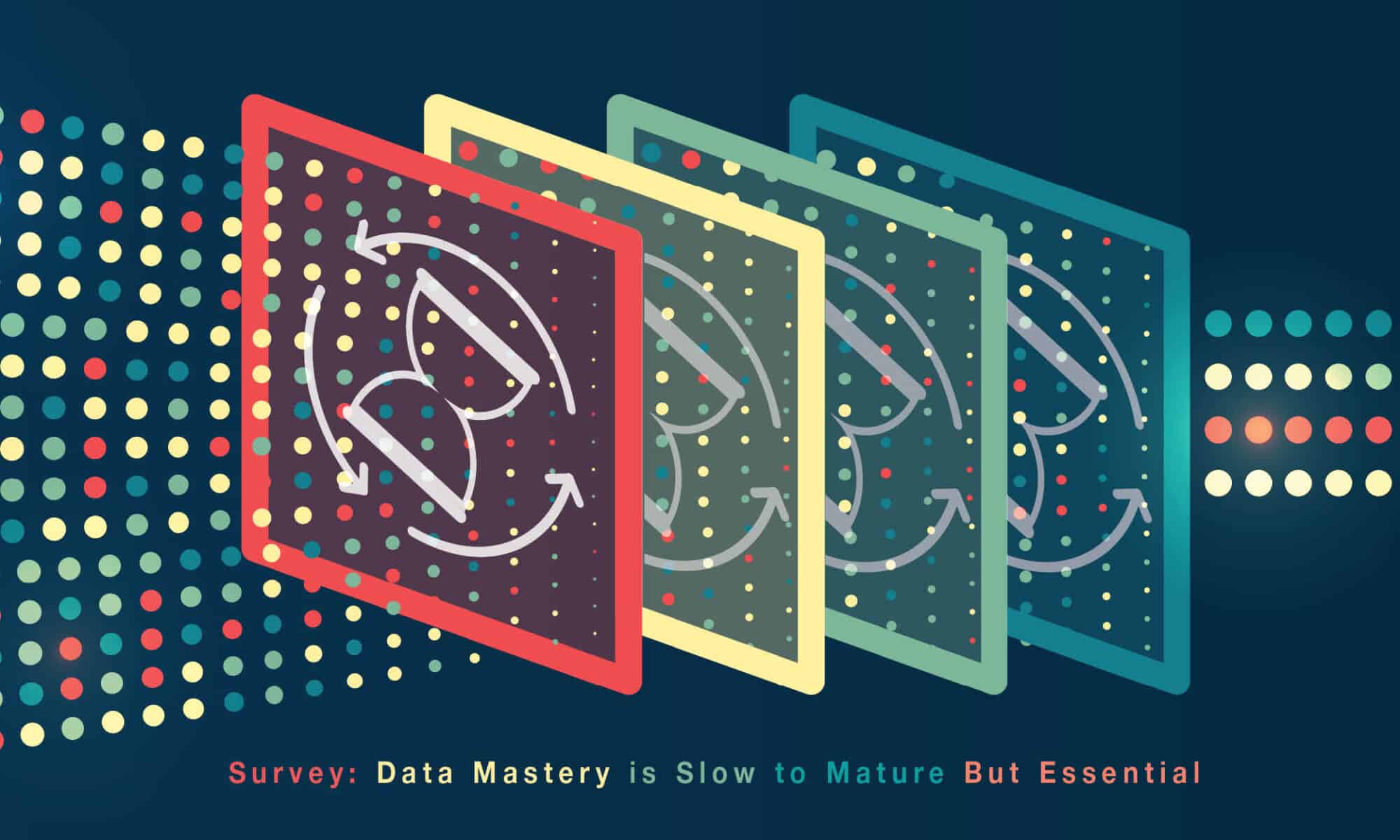
Manufacturers show some progress with data mastery efforts, but much opportunity for growth exists.

When MLC last fielded its Data Mastery survey in 2021, senior content director Penelope Brown wrote of the results, “Manufacturing data mastery is in its tween years for most enterprises – certainly past its infancy, but still awkward and gawky and not quite fully formed.”
If data mastery was a tween then, the effort is on the final stages before becoming a teenager now. Like a tween, there has been some maturation but also some regression in how companies are accessing and using data and analytics. Likewise, companies can see dramatic development in specific areas of data utilization, but each organization seems to mature at its own pace while encountering a wide array of challenges and pursuing various desired outcomes and focus areas.
Why is progress slow? To further the tween metaphor: perhaps it is growing pains. More than one-third of respondents tell us that the volume of data they’re collecting has at least doubled. Nearly 20% say the amount of data has at least tripled. Before this exponential growth came into play, companies were already dealing with an uphill climb to verify and analyze data. Given this rapid growth – like in tween years – there’s bound to be some awkwardness and slower progress.
Still, it is clear from the 2023 MLC Data Mastery and Analytics survey that mastering manufacturing data will be essential to future competitiveness. Presently, 91.1% of respondents report that data has allowed for more accurate or timely decisions, both of which are essential to overcome the pressures that businesses face now and those they will face as their data mastery skills continue to mature.
Read on for key findings and selected graphs from the 2023 Data Mastery and Analytics survey.
Part 1: Data Strategy and Governance
The majority of respondents have a formal data plan and guidelines in place, but there has been little change since the last time we fielded this survey in 2021. Currently, 56.5% of respondents say they have a corporate-wide plan, strategy, or formal guidelines for how data is collected and organized. This number sat at 55% in 2021.
Q: Does your company have a corporate-wide plan, strategy, or formal guidelines for how data is collected and organized across the enterprise, including manufacturing operations? (select one)

For those with a formal corporate-wide data strategy, nearly all (90.5%) see at least some alignment to overall business strategy, but only 52.4% say it aligns entirely or very closely.
Q: If your company has a corporate-wide plan, strategy, or formal guideline for how data is collected and organized, how closely do you feel this data strategy is aligned to your company’s overall business strategy? (select one)

Measuring data’s value is still elusive to many organizations. However, there’s been increases in assigning monetary value and measuring revenues of data-driven services in the past two years. In fact, 22.6% of respondents now say they measure the value of data in monetary terms compared to 4% in 2021. Meanwhile, 12.1% say they measure data’s value by revenues of data-driven services compared to 3% in 2021.
Q: How do you measure the value of the data in your organization? (select all that apply)

Manufacturers see a slight positive shift in their ability to collect the right data the business needs. In 2021, 16% of survey respondents ranked their company as highly able to collect the right data. In the latest survey, that number has climbed over 20%. On the low end of the spectrum there was only minimal change moving from 26% in 2021 to 26.8% in 2023.
Q: How would you rank your company’s ability to collect the right data the business needs from your manufacturing operations? (select one)

Part 2: Data Collection, Use, and Analysis
The ability to analyze manufacturing operations data is an opportunity for growth. Just over half of respondents report their company is moderately able to analyze the data, while 30.4% say they have low competency.
Q: How would you rank your company’s ability to analyze the data from your manufacturing operations? (select one)

Shop floor systems and ERPs remain the primary data sources. In fact, shop floor systems use increased from 79% in 2021 to 88.4% in 2023, while ERP systems increased from 77% in 2021 to 83.9% in 2023. Quality control systems, equipment maintenance systems, supply chain systems, and robotics systems saw similar increases since the previous survey, but product development systems fell 16 percentage points to 22.3%.
Q: What are the primary systems that generate your manufacturing data today? (select all that apply)

The survey revealed that there is considerable room for growth in real-time data collection. Less than half of respondents report their company’s data is comprised of 51% or more real-time or near real time data.
Q: What proportion of the data you collect today is real-time or near real time, not batch or historical? (select one)

In the past two years, companies are collecting more manufacturing data. Eighty percent report they’ve seen at least some increase in the amount of data collected. Meanwhile, more than one-third of respondents say the amount of data has at least doubled in that time.
Q: What has been the percentage increase in the amount of manufacturing data you are now collecting compared to two years ago? (select one)

Looking ahead at the operational focus for data projects in two years, respondents foresee a varying shift from manufacture, quality, maintenance, inventory, logistics, and assembly to process control, supply chain, track and trace, inspection, security/data protection, and tooling.
Q: What are your primary areas of operational focus for data projects today and what do you expect the primary focus will be in 2 years’ time? (select top three)

Microsoft Excel remains the reigning champion of data analysis tools. In 2021, 71% of survey respondents reported that Excel was in their data analysis toolkit. That number rose slightly in 2023 to 72.3%. Statistical analysis programs of standard BI systems jumped from 47% in 2021 to 60.7% in 2023. This moved it from the fourth most used tool in 2021 to second place this year. Meanwhile, manufacturers are increasingly outsourcing analytics, with 24.1% utilizing external analytics partners this year compared to 14% in 2021. Somewhat surprising, the use of AI systems has decreased from 48% (when taking in-house, cloud and external AI partners in aggregate) to 41% in 2023.
Q: What systems do you use to analyze the manufacturing data you collect? (select all that apply)

Respondents’ companies are evenly split when asked about verifying the accuracy and quality of raw data. About 46% report they have a process while approximately 45% say they do not. In the 2021 survey, for comparison, 49% reported they had a process while 46% reported they did not.
Q: Does your company have a process to verify the accuracy and/or quality of the raw data before decisions are made on it? (select one)

Part 3: Outcomes and Challenges
Increased data access has resulted in a variety of operational improvements. Leading the charge are cost reductions, productivity improvements, efficiency, quality, and uptime – all of which were cited as an improvement seen by 50% or more of survey respondents.
Q: In what ways has increased access to manufacturing data helped you to improve your manufacturing operations? (select all that apply)

Cost reductions are the primary motivator for new manufacturing data projects now, and this is expected to remain constant in two years. In fact, 65% of 2021 survey respondents anticipated that reduced costs would be a key business outcome objective this time around – a number that tracks closely with the 67.6% that listed reduced costs on this year’s survey. While reduce costs is anticipated to lead the charge again in 2025, the number is anticipated to decrease by 10 percentage points in that time. The biggest upward movers by 2025 are expected to be improved production speed, integrated processes, improved supplier network effectiveness, improved security, and monetizing data.
Q: What are your key business outcome objectives for embarking on new manufacturing data projects today and what do you expect the outcome objectives will be in 2 years’ time? (select top three)

Data improves accuracy and speed of decisions. Half report that decisions have been more accurate and 40% point to more timely decisions. Only 6.3% of respondents report that there has been no change in their company’s decision-making because of data availability, while less than 2% of respondents, respectively, cite slower or worse decisions as the most prevalent way that data has affected their decisions.
Q: What is the most prevalent way that data has affected your company’s decision-making? (select one)
Survey respondents report that many challenges or obstacles are hindering their company from making more data-driven decisions. The leading challenges – each cited by 39-49% of respondents – are extracting data from legacy systems, lack of skills to analyze data effectively, and integration of data from different sources.
Q: What are the most important challenges or obstacles hindering your organization from making more data-driven decisions? (select top three)

Three out of four respondents report that data mastery is essential to their business competitiveness in the future. This 75%/25% split remains consistent with responses to the 2021 survey.
Q: Looking forward, how important will mastering manufacturing data become to your competitiveness as a future business? (select one)

About the author:

Jeff Puma is Content Director for the Manufacturing Leadership Council
Survey development was led by the MLC editorial team with input from the MLC’s Board of Governors.
Dialogue: Developing Pella’s Data Driven Culture
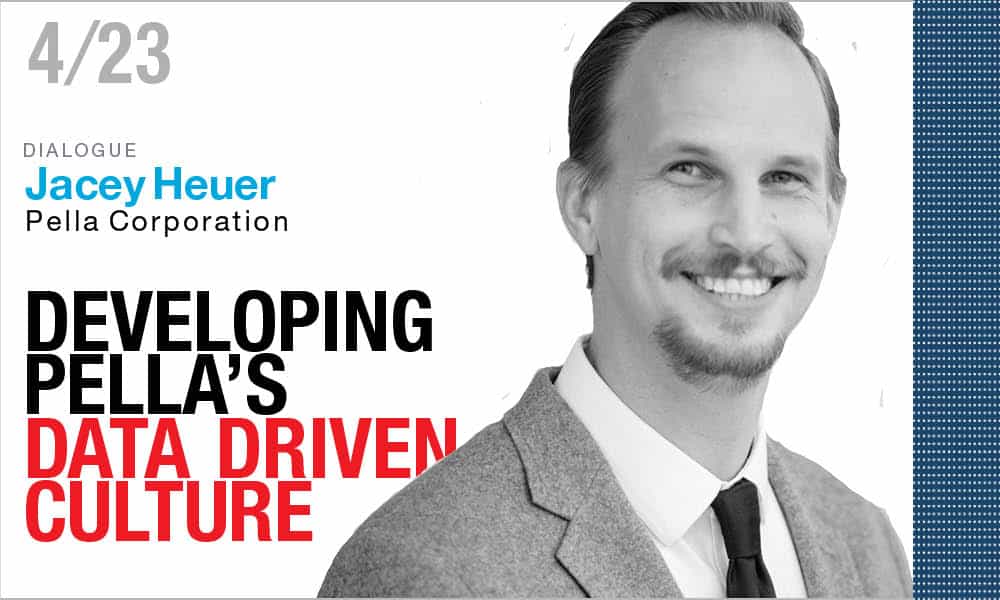
Creating a culture where all employees understand the importance of data to driving operational improvements and value is crucial to the future of manufacturing, believes Pella’s Head of Advanced Analytics, Jacey Heuer.

“What drives me is being part of that blank canvas and having the opportunity to create something with data analytics that is so game changing not only to Pella, but to the whole industry.”
Jacey Heuer, Head of Data Science and Advanced Analytics, Pella Corporation
Pella Corporation was founded in 1925 when lumber business owners Peter Kuyper and his wife Lucille acquired a small manufacturer of roll-up insect screens called the Rolscreen Company and moved the business to Pella, Iowa. As Pella approaches its centenary in 2025, the company has now grown into an award-winning $2 billion enterprise, with 10,000 employees, 17 manufacturing plants across the U.S., and one of the largest window and doors manufacturers in the U.S.
In our latest interview with an industry thought-leader, Pella Corporation’s Head of Data Science and Advanced Analytics, Jacey Heuer, talks to the MLC’s Executive Editor Paul Tate about transforming a mature corporation in the digital age, the need to build a solid data foundation to help reimagine traditional processes, harnessing data analytics and AI technologies to create new insights, and creating a culture of ownership where every employee understands the true value of data to improving the future of the organization.
Q: What excites you most about your role at Pella?
A: It’s the nascent nature of data and analytics in the manufacturing industry, especially in advanced data science and machine learning AI environments. Historically, there have been data and statistics and optimization initiatives in many different forms, like Six Sigma, Lean, and traditional business intelligence systems, which have been around for decades. That’s the precursor to what we’re trying to create now with the next generation of data driven solutions.
My focus is on how we accelerate to that next level of leveraging our data at Pella to drive greater economic value and greater impact across the enterprise – from customer experience and marketing, to improving the P&L and optimizing throughput capacity in manufacturing operations.

“The challenge is how do we tear the traditional processes down to introduce a new data solution that drives improvement? That’s the greatest part in all this. It’s re-imagining the way things are done.”
A lot of this stems from how we collect data. In the past, there’s been almost a taboo around adding individual transactions to data resources. Traditionally we’ve tried to eliminate that transactional data to create more efficiencies and productivity. Yet, all those transactions are data rich sources of what’s really happening as materials or products go through a facility.
This is one area where my team is now helping to change that perspective because, in a data-driven world, those transactions are valuable to us to help us continue to develop greater optimization, more insights from AI and machine learning, and better outcomes. What drives me is being part of that blank canvas and having the opportunity to create something with data analytics that is so game changing not only to Pella, but to the whole industry. There’s a lot of excitement and opportunity in that.
Q: How are Pella’s data analytics and data governance activities structured within the organization?
A: The corporate Data Analytics and Insights team, which I help to lead, is around 14 people right now and it spans core roles in data science, data analytics, data engineering, data governance, and data quality.
Our vision is a hybrid model where each plant still owns some of their data and analytics, but we at least have a governance role or advisory role in how those plants and different facilities are leveraging and using that data. I fact, we prefer to use the term data enablement, as opposed to governance, because it has a more positive connotation.
We’ve also established a corporate Data Council, and a layer of data stewards who are the front-line owners of data analytics in different facilities and are our main conduit to make sure that we’re developing and rolling out solutions in an effective manner.
The Data Council meets on a quarterly basis and includes directors and senior level leaders who provide executive sponsorship and buy-in, oversight, guidance around prioritization and what’s most important, and help steer how we drive forward. These leaders act as a megaphone for us and go down into their functions to help drive the change in mindset around data generation and use.
Further down, we also have the layer of data stewards. These are people on the frontline who may have developed a legacy system, or are in our continuous improvement environment, or in our engineering space, and are the true data owners who interact with data day-to-day. We have a roster of these data stewards, and we meet with them on a monthly basis to continue to develop a culture of data ownership and an understanding around the importance that data needs to play as move to the next generation for Pella as a data driven organization.
Q: What are the main data analytics initiatives now underway at Pella?
A: There are two key initiatives, both targeted ultimately on improving the customer experience. The first is a smart factory initiative. We have two plants that are developing different elements of a smart factory. One plant is focused more on automation, so autonomous vehicles, robotics, and those kinds of technologies. The other plant is focused more on process optimization. There’s a lot of cross-over between those, but that’s they’re starting focus.
The other key initiative is reliable delivery. We have a goal of “industry best” reliable delivery at Pella. So, we are working on how we ensure on time delivery by fully leveraging the data and applying predictive modelling using AI and machine learning technologies.

“If you don’t have a focused diligent investment into the type and frequency of the data you’re collecting, your AI and machine learning outputs are likely to struggle and perhaps fail.”
Within both of those initiatives is a focus on people, understanding individual capabilities and skills so we can optimize the role they are working on in the factory and make sure they are placed in the best position to help drive optimization.
Q: How are you integrating the data generated by legacy systems into the new analytics framework?
A: Legacy systems historically tend to be production databases where the data only exists for a short length of time before it’s purged out. We’re now applying more event-driven monitoring technologies where we can monitor each system in more detail and anytime a new event occurs, we’re taking that data out and moving it into our data lake environments to create a history of all the data. We’ve introduced technologies using application interface layers (API) that essentially provide one entry point for all those legacy systems. This helps us gain greater access to the legacy systems and move the data more easily to locations where data scientists can then work with it, or machine learning can happen, which is mostly in our cloud environment.
On top of that, from a front-end consumption standpoint, we’re developing our own internal applications so we can take the output of our AI data science models and feed it into those applications where we have more control over the user interface and experience for the people who need the information. That helps bridge that gap from the legacy to the modern, and helps develop the people, the resources, and the skills we need to make the transition occur.
Q: Once you’ve gathered all this data and analyzed it to give you new insights, how do you then operationalize those insights to drive better decisions?
A: That’s a great question. This is where the network of data stewards and the data council becomes crucial. Ultimately, they’re the people who are helping us connect with the users on the shop floor, the line managers, and the production managers, who are going to be consuming these outputs. And it’s also about how we deliver that information to the users. Think about your phone, or Facebook, or Google. There’s a whole team of individuals focused on your user experience. Historically, when you are getting a model or AI solution into production, a lot of its downfall can be because of the user experience. It can make a cool prediction, but as a user, it’s not always intuitive to use. Or there’s other reasons that might limit a person’s willingness to adopt it. We’re now leaning into that aspect of how we actively engage with our users to make sure we’re creating the right user experience so that our outputs are meeting that need. That’s helping to drive a lot of consumption and adoption.
Q: How are you harnessing AI technologies to help drive this data-driven transformation?
A: AI and machine learning are fueled by data. Like a car, or a tractor, or any big piece of machinery, it’s the fuel that makes it productive. It’s the same with AI. That data foundation is where a lot of our focus has been initially and on how we continue to influence the type of data we’re creating. I mentioned event driven technology solutions, for example. That stream of event data coming in means that we’ve now got much more clarity from when an order enters our system, to every event along its journey, to when it exits. We can see the timing and the context around that journey. We’re now able to build predictive models that are much more accurate on when an order reaches different milestones to ensure it can be delivered on time and in full to the customer. That’s an area that we’ve had a big initial impact in building predictive models that drive scheduling and the decision points along the way. On the smart factory side, for example, we’ve got a big focus on process optimization. There can be somewhere between 1,000 and 5,000 carts moving around our door facility at any time, which is where our automation focus on smart factory is happening. We’ve now applied RFID tags to the carts so we can collect passive signals as they move through the facility. We’re then leveraging that data to improve route optimization within our plants because we are able to establish see a clear linkage between the impact of delays at certain points in that process to lost units created that day. There’s clear value in that use case. The next stage is to understand how we can best scale that across our 17 plants.

“One of the key leadership skills for the future is greater trust in the individuality of all the team members, all the workforce and allowing them the freedom to create, to think, and to make decisions.”
It’s that kind of data foundation that’s going to fuel many more AI use cases for us as we go forward. Of course, understanding the intrinsic value of having a strong data foundation is something that’s not always intuitive for everyone to grasp. That’s an area where our storytelling has continued to evolve for our leadership and our plants about why investment in those technologies is going to serve us in the long-term. If you don’t have a focused diligent investment into the type and frequency of the data you’re collecting, your AI and machine learning outputs are likely to struggle and perhaps fail.
Q: What key challenges still keep you awake at night?
A: One of the core challenges is cultural. We’re trying to change the mentality so that everyone in the company has a greater understanding that every point of data, every action that someone on the shop floor or in manufacturing takes, either does, or will eventually, generate some data point that’s going to be crucial input to helping improve their lives, improve the P&L, and improve our impact as an organization as we go forward.
Another challenge, but a good challenge, is how we solve some of the technical aspects of creating a data-driven organization and re-imagine the processes that currently exist. We can develop models, develop solutions, push them to the five-yard line and are ready to hit the end zone, but then we come up against a wall of the way things have always been done. People say, “Well, this is the process”. The challenge is how do we tear that traditional process down to introduce a new data solution that drives improvement? That’s the greatest part in all this. It’s re-imagining the way things are done. In a hundred-year-old organization with a hundred years of legacy and processes in place, that’s what keeps me up at night in many ways.

“Eventually, anybody who interacts in the organization and takes an action will be able to understand how it impacts the bigger network of what’s happening.”
Q: Looking ahead, what would you highlight as the greatest challenges and opportunities for manufacturing industry as a whole for the rest of the decade?
A: I think there’s a great opportunity to create a truly connected network of data within a manufacturing organization, so that if a decision is made on one side of the business, people can see the impact that decision has way over on the other side. Eventually, anybody who interacts in the organization and takes an action will be able to understand how it impacts the bigger network of what’s happening. For example, if I make a decision to reorganize some physical part of a plant, I can see the expected impact on the other plants that are outside my immediate location. It’s a connected network of understanding, supported by a focus on the data foundation and driven by investments and front-line engagement in creating that data foundation.
Q: What key leadership skills, attributes, and roles do you feel that senior industry executives now need to lead successfully in an increasingly data-driven world?
A: One of the key leadership skills for the future is greater trust in the individuality of all the team members, all the workforce and allowing them the freedom to create, to think, and to make decisions. As people get more transparency and more understanding of the connectedness of every decision they are making, their knowledge of the true scale of impact is going to increase, so they should be able to make better informed decisions and take better informed actions. In an established legacy organization, it’s a different mindset to allow individuals that freedom and capability. From a leadership standpoint, it’s about being okay with that flexibility and that freedom.
Q: Finally, if you had to focus on one thing as a watchword or catchphrase for the future of manufacturing, what would that be?
A: It’s intelligence augmentation. I like that term because I think it captures, in those two words, the role that artificial intelligence and machine learning and data should play, and will play, in organizations in the future. It also highlights that humanity, people, are not going to go away, and that we need to ensure there’s teamwork between those people and the new technologies that will come our way. Intelligence augmentation captures that well. M

FACT FILE: Pella Corporation
HQ: Pella, Iowa
Industry Sector: Windows and Doors
Revenues: $2.17 billion
Net Income: (Privately held)
Employees: 10,000+ Employees
Presence: USA
Production Sites: 17+ Manufacturing Sites
Website: www.pella.com
EXECUTIV PROFILE: Jacey Heuer
Title: Head of Data Science and Advanced Analytics, Pella Corporation
Nationality: American
Education: BA degree, Business Administration – Finance & Economics, Wartburg College; Masters’ degree, Business Analytics and Data Analytics, Iowa State University; MBA, Iowa State University
Languages: English
Previous Roles Include:
– Data Scientist, Pella Corporation
– Data Science Author, Pluralsight
– Data Scientist, Brownells, Inc.
– Senior Pricing Strategist, MidAmercian Energy
– Assistant Vice President, Situs RERC
– Financial Analyst, The Members Group
Other Industry Roles/Awards/Board Memberships
– Golden Key International Honour Society, Iowa State University
– Iowa Technology Leadership Institute member
About the authors:

Paul Tate is Co-founding Executive Editor and Senior Content Director of the NAM’s Manufacturing Leadership Council.
Case Study: The Future Starts with Citizen Data Scientists

How IBM is developing the next generation of transformation-drivers by turning supply chain SMEs into Citizen Data Scientists

Company Fact File
Name: IBM Corporation
Sector: Information Technology and Services
HQ location: Armonk, NY
Revenues: $10 billion plus
Employees: 5,000 plus Employees
Web url: www.ibm.com

When COVID-19 hit, IBM Supply Chain found that its digital transformation journey had enabled the resiliency needed to tackle major disruptions. That awareness led to the decision to further accelerate their digital transformation projects. To keep up with the demand of exploiting emerging technology while preparing for future, IBM launched a first-of-a-kind transformational upskilling initiative designed to democratize data while empowering individual business technologist (SMEs). This transformative initiative is a prime example of the mantra Ron Castro, IBM Vice President and Chief Supply Chain Officer, constantly challenges his organization with “innovate anywhere, use everywhere.”
The initiative, dubbed the Citizen Data Scientist (CDS) Certification program, was designed to help supply chain SMEs develop the data science skills they need to make data-driven decisions in a fluid business environment — and then roll it out to the rest of the company to engage employees in successful process improvement throughout every part of the organization.
In just the first year, the CDS program developed by IBM Supply Chain, in partnership with the IBM Data Scientist Profession Team, the company already was seeing results. The first supply chain SME cohorts to go through the program’s data science, data wrangling, and data visualization upskilling and reskilling structured learning program resulted in more than $1.6M in efficiency and productivity improvements and inventory savings from improved decision-making.
All this in just six months, and with zero financial investment. And the program has only continued to grow ever since in both the breadth of its content and its reach across the company.
What Is a Citizen Data Scientist?
As manufacturing moves into M4.0, the role of big data is only getting bigger — and more ubiquitous throughout operations. Data scientists, who usually have a master’s or PhD, are essential. However, there may not be enough of them to go around, and even if there are, their level of business expertise may not be sufficient in a specific domain.
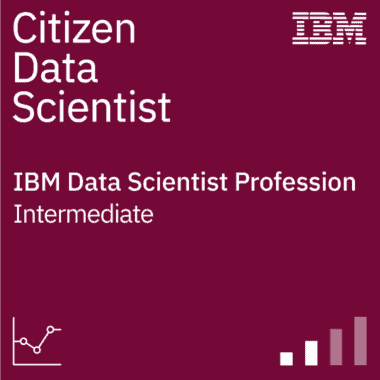
Hence the rise of the Citizen Data Scientist. According to Gartner, a citizen data scientist is “a person who creates or generates models that leverage predictive or prescriptive analytics, but whose primary job function is outside of the field of statistics and analytics. They bridge the gap between those doing self-service analytics as business users and those doing advanced analytics as data scientists.”
IBM’s Citizen Data Scientist digital credential is designed to create more of these data-savvy employees so they can bring the power of data analytics to aspects of their daily jobs without having to rely on those who call data science their profession. At IBM, the CDS certification also is integrated into the company’s career path, so it serves as a starting point for those who might be interested in becoming a full-fledged data scientist.
Starting with an Innovation Foundation
The CDS certification program was established on a foundation of innovation that would encourage continuous transformation. One bedrock of this foundation was to reimagine and transform people’s analytical skills using IBM and open-source technology to retain and create a high-performing, engaged culture. Another was to leverage the reskilled SMEs to reimagine processes, then apply AI and Cloud technologies to implement new processes to accelerate transformation.

“The CDS certification program was established on a foundation of innovation that would encourage continuous transformation.”
“We wanted to certify people who could really work on data to bring our broader population into IBM’s digital transformation,” says Matthias Graefe, IBM’s Director of Supply Chain Transformation. But it isn’t enough to just offer one-off classes in, for example, Python programming, which would likely result in the creation of isolated applications and solutions. The company also wanted to ensure that its latest crop of Citizen Data Scientists has an understanding of cybersecurity, because a talent in programming doesn’t automatically mean the person understands how to ensure the programming, they’re creating is also compliant, Graefe says. “We knew we wanted to achieve both sides of it — enabling people in a supportive way, while also creating a community and governance around what they are doing.”
Taking the CDS Challenge
Brenda Berg, CDS Program Manager, advises that the CDS program requires more than just watching some videos and taking a test to earn the digital credentials. It may not be as difficult as becoming a full-fledged data scientist, but the Citizens Data Scientist certification still is no walk in the park. In fact, only 70% of the first year’s CDS trainees made it through the program. The nature of the learning, uninterrupted time commitment and demanding day jobs are what makes the program challenging.
To help keep candidates on the learning path, the program is highly structured and includes having a technical leader, a program manager, and a project manager agree to facilitate the process. Each candidate also is assigned a mentor to help them develop the data scientist mindset and build the new ecosystem together with professional data scientists. Employees who chose to participate could leverage their allocated IBM global training program learning hours to gain data science knowledge and skills.
CDS candidates initially were chosen by their managers because it takes a true commitment on both the participant and their managers, says Giovanna Benetti, Digital Supply Chain Transformation Leader. The self-paced training is done in parallel with participants’ day-to-day jobs, so both their managers and the participants need to ensure that they can complete the program while still getting their daily work done.
The data science mentor role also is a key one, she adds. They meet regularly with CDS participants to assist with coursework understanding, application, and provide guidance on the required Citizen Data Scientist project plan to complete the certification. Now that the program has an established, and growing, bank of certified Citizen Data Scientists, the idea is that some of those who have been through the program can now turn around and assist new trainees within the CDS community. Or, as Anita Toth, Global Supply Chain Manufacturing Operations and Integration Manager, says, “We now have started to eat our own cooking. The people who have graduated from the CDS program are now applying their skills back to the business, either vertically in their own domain or cross-organizationally. We have some Citizen Data Scientists who just graduated one year ago who now are guiding people who are currently in the program.”

“A key component to the program is that participants also must apply what they are learning to real-world projects.”
Another key component to the program is that participants also must apply what they are learning to real-world projects. These projects generally fall into three buckets. One is what IBM calls “big rocks,” which are multidomain, large-scale projects that are important to the organization overall. “It’s a benefit for employees to work on these big rocks projects, because they can both experience different functional areas, and are able to contribute on projects that have a big impact,” says Graefe. Then there are smaller projects, or “pebbles,” which generally fall within a specific business or functional area, and even smaller, more specific “sand” projects. Of course, the big rocks projects result in the most material savings — and the highest visibility. As an example, a 2020 CDS participant’s pebble project resulted in a $50K inventory savings for his business unit. After CDS graduation, he partnered with CDS multidomain colleagues to drive a services and manufacturing synergy project. Over the past two years this advanced deep learning-machine learning model contributed over $10 million in inventory savings and cost reductions.
The key to successfully completing the program is for the candidate to have the support of their manager or supervisor, and their entire team. Erin Thalacker, CDS Project Manager, also advises it’s vital to connect early and often with their data science mentors so everyone understands what business problem they’re trying to solve through data science, and also make sure they have access to data and that they understand that data, as well as for help navigating any roadblocks they may hit along the way.
The program still is tough, but those who make it through feel more prepared to be the technologists IBM will need for a future in which automation and data analysis will continue to be increasingly key for most job roles. Having a mentor also is a big boost for many who go through the program, as is having a community of fellow Citizen Data Scientists who not only understand what they are doing, but also can share solutions to common challenges across functionalities. Another perk? Added visibility. “We have a strong sense of community across Supply Chain, and to be able to make an impact in that community is a strong driver within the program,” says Graefe.
Scaling Up
As important as it was to quickly reinvent the supply chain, the program also was designed to be scalable throughout the company by basing the CDS on data science methodology, tools and data trainings that were domain-agnostic. This means that the program can be replicated for any other part of the organization that wants to jump-start its transformation journey with reskilled, resilient, Citizen Data Scientist SMEs.
This is already starting to happen. The original Citizen Data Scientist certification program has been leveraged to pilot additional Citizen Process Designer, Citizen Automator, Citizen Front End and Backend Developer programs.
There was a strong use case already built-in for expanding the program, says Graefe. For example, as IBM continues its drive toward automation, there is a need to create more bots. But those bots need to be programmed so that they add to the greater good — otherwise, they could just create chaos. Also, he says, there was a need to use a common platform and tool set so people can share successful components as they scale up the automation. “If we want to eliminate, simplify and automate, and to drive automation everywhere into our workflows, we need to expand the Citizens program,” he adds.

“The program was designed to be scalable throughout the company by basing the CDS on data science methodology, tools and data trainings that were domain-agnostic.”
“If you need to develop an application, you need people who understand the business requirement, can write the code, and you also need people who can design the UI for the application on the front end. Then you have the automators on the back end. Also, now it’s not just about developing code; it’s about working on platforms, often with low-code applications — you often don’t need deep coding skills now. We wanted to bring all of them under one Citizens umbrella.”
Next up is a pilot program with another business unit that works closely with Supply Chain to see if they can “lift and shift” to make the CDS program work for their specific needs. The team also is close to implementing an overall system to manage the projects the prospective Citizen Data Scientists will be working on so innovations can be shared on platforms with communities who could link those innovations to other areas.
“Our next step is to scale up the CDS to Innovation Technology and get through the pilot, then open it up to the broader IBM community,” says Graefe. “We are creating a community of those who finish their projects and graduate, who then are offered the opportunity to become Citizen Technologists and work across transformation projects to co-create across the supply chain and, hopefully, across IBM in the future.” M
About the author:
Sue Pelletier, a contributing editor with the Manufacturing Leadership Journal, is a seasoned writer/editor with experience in online, social media, e-newsletter, tablet app, book and e-book, and print publications.
The Journey to Analytics Maturity
Manufacturing Leadership Journal content and MLC resources are exclusively available to MLC members. Please sign up for an account or log in to view this content.
M2030 Perspective: More Robots, Better Jobs. But How?
Manufacturing Leadership Journal content and MLC resources are exclusively available to MLC members. Please sign up for an account or log in to view this content.














